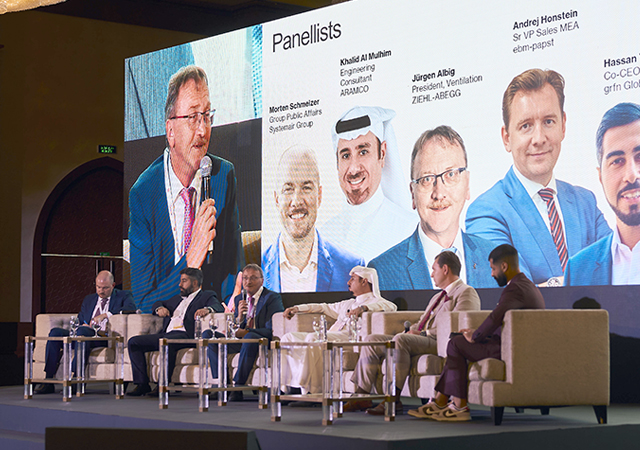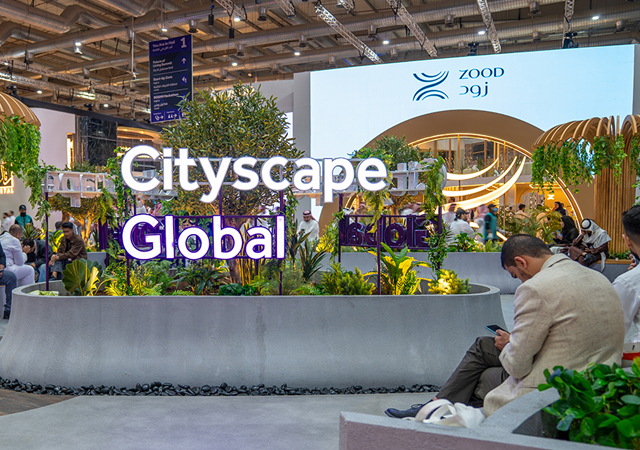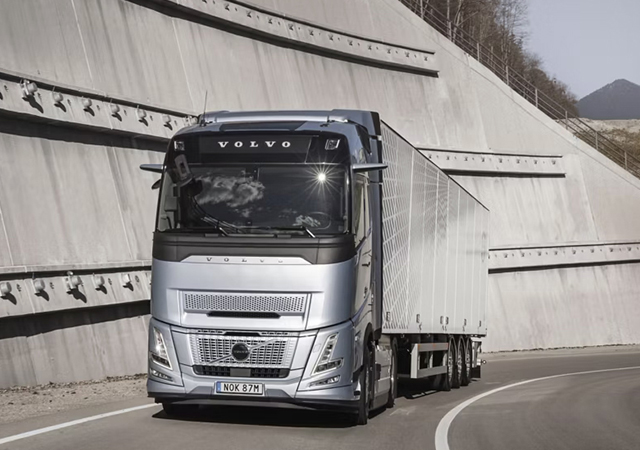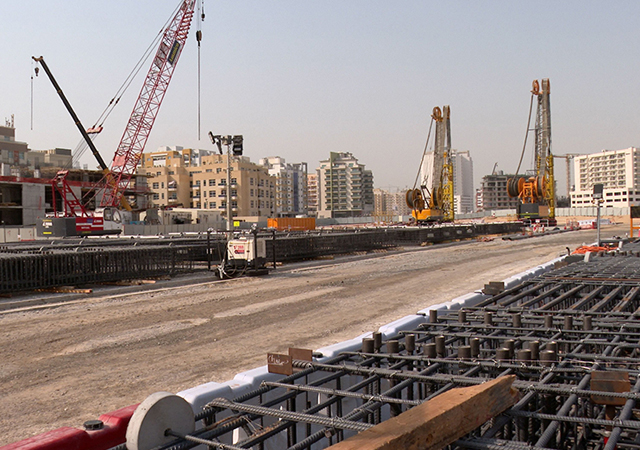
 The KAFD vision ... an artist’s impression.
The KAFD vision ... an artist’s impression.
CONSTRUCTION work is under way on the King Abdullah Financial District (KAFD) in Riyadh, designed to be one of the largest financial centres in the Middle East, with contracts having been awarded on at least 10 packages on the project.
The project occupies a 1.6 million sq m site in the capital city close to the main business district of Olaya. The development will include offices, hotels, conference centre, shops and recreational facilities, within easy reach of the city centre and airport and well served by the road network.
The KAFD is designed as a state-of-the-art and fully self-contained centre for doing business and facilitating investment and enterprise in the kingdom and, in due course, in the wider region. The international financial district offers a wide mix of offices, residential, educational, sports, recreational and cultural facilities in different types and densities.
Conceived as part of the overall economic diversification programme, the custom-built financial district aims to providing the financial community with a state-of-the-art working environment over an area of 3.3 million sq m.
The KAFD will be the headquarters of the Middle East’s largest stock exchange (Tadawul) and for its watchdog, the Saudi Capital Market Authority (CMA). The district will also be the headquarters for the Commodity Market, and for the country's financial institutions and other service providers such as accountancy and legal firms, rating agencies, consultancy firms, and IT service providers.
The masterplan for the KAFD divides the new financial centre into three areas:
• The Leaf, which will be the heart of the KAFD. It will be a mixed-use area, consisting of 23 per cent residential, five per cent retail and the rest high-quality office space. Two-thirds of the area will be public realm, including major attractions such as an aquarium, a museum, hotels, an exhibition centre, a conference centre and mosques;
• The North West Areas, which will include support services, utilities and parking located in the northwest; and
• The South Area, which will be residential and office accommodation.
At the centre of the KAFD will be a modernised concept of a wadi – a central waterway, around which will be established an attractive working ambiance for the growing workforce in the financial sector. Thus, there will be big squares and parks, cafes and restaurants and sports arenas for football, basketball and volleyball.
The owner and prime developer is Saudi Public Pension Agency (PPA), which has awarded a five-year project management contract to the US-based Hill International.
Construction is in progress on a number of buildings that form part of the project. Saudi Oger is responsible for the construction of a hotel, which is being built on a 5,645 sq m site and an office building, which will take shape over a 6,407 sq m plot. The 83-m-high hotel, which will provide a built-up area of 30,311 sq m, has being designed by Goettsch Partners, while the 100-m-high office building has been designed by King Stubbins and offers a built-up area of 54,641 sq m.
All the other packages awarded have been for mixed-use buildings. Four of these packages for office, residential-cum-commercial buildings — which range in height from 88 m to 132 m — have been designed by FX Fowle and have been contracted to the Binladin Group.
Among other buildings, El Seif is building a 154-m-high mixed-use tower over an area of 6,548 sq m with a 64,017 sq m built-up area; and another 105-m-high mixed-use building over an area of 6,551 sq m with 36,189 sq m of built-up area. The buildings have been designed by Callison.
The remaining two contracts for mixed-use constructions have been awarded to Saudi Constructioneers and involve two medium-rise buildings, one 83-m-high structure over 7,847 sq m and with a total built-up area of 43,109 sq m and the other 61-m high over a 6,859 sq m site and 30,003 sq m built-up area.
Masterplan amendments
The masterplan, prepared by Shankland Cox Consultants in Hong Kong, has recently been amended; the major revision being the superimposing of a ‘land bridge’ in extension to the ‘Wadi’ to integrate Area 6 with the ‘leaf-shaped’ outline of the project, and used as a recreational park, says a spokesman for the developer. Also the international hotels in the district with dedicated car-park buildings and underground central parking have been relocated.
In terms of the vehicular network, the major change is the elimination of the double-decked circulation all through the project, except for Area 1. The hierarchal circulation, however, from ring road to access roads and further down to streets and cul de sacs has been preserved as per the original plan. This change was realised by vehicular network design in terms of widths and levelling in connection with buildings.
The project will provide parking space for 40,000 cars located largely on the perimeter and notably in the northwest area. Travel within the “noise barrier” will be by monorail and by giant skywalks – which are described as giant bridges in the sky linking multi-storey buildings. The skyways will be climate-controlled and modelled on successful earlier innovations such as the 16 km of skyway linking the main buildings in Calgary, Alberta, in Canada.
The skywalk network connects the commercial podiums of buildings at 6.4 m height. “The network is superimposed at two urban scales, forming a major loop at the entire project level, and minor loops at the scale of each area of the project,” says the spokesman. “The monorail, nevertheless, is kept in a loop circulation with stops at the major recreational and entertainment facilities of the project known as ‘attractor buildings’ in major public plazas.”
The monorail runs in one direction over the skywalk level, with a possibility to link with the planned public monorail along the nearby Olaya Street on Riyadh City level in the future.
Landscaping
The hard landscape elements are structured along the ‘wadi’ spine and comprise the financial plaza in Area 1 featuring the highest buildings in the project; nine plazas surrounding major public buildings as poles of attraction on the wadi promenade; minor space-creating plazas for individual building parcels; cul de sacs of pedestrian amenities; building roofs which are designed to encourage public access for recreational activities such as restaurants, roof gardens and the like; and a land bridge linking the ‘Leaf’ with Area 6.
Soft landscape elements are characterised by palm trees accentuating the course of the wadi, in addition to palm-tree-lined boulevards. Green sports field located in Area 5 enhance the surrounding environment as a major landscape element.
The wadi is 5.5 m deep with varying widths and accessed by escalators and ramps distributed along its length. Building façades edge the wadi to enhance its depth and add to the dynamics of its character. The wadi’s recreational and retailing activities extend into the building spaces at that level.
Utilities
The project adopts green architectural aspects such as solar energy utilisation, gray water recycling, environmental control and wind studies. The mains of the utility ducts are tunnelled following the wadi course, and branch under the vehicular network into individual building outlets.
The KAFD adopts the district cooling system with the plant located in Area 6 outside the ‘Leaf’. Electric power supply is provided at 132 kV in zoned power stations of the Leaf. Transformers drop down power into 220/127 volt or 380/220 volt at the service point.
Security is one of the major issues at the KAFD and measures are taken at different levels to include circulation control, checkpoints and sophisticated devices.
The KAFD is designed to enhance Saudi Arabia's financial position in the region by forming a central financial community to make Riyadh a regional financial hub.
The project spokesman says the KAFD will play a major part in the diversification of the world’s major oil economy. “The whole Saudi economy will benefit, but especially the PPA’s pensioners, who will gain from the profit generated from our ownership and management of the KAFD project,” he says.
The PPA sponsors investment projects that are beneficial to the equity of the pensioners, and help to support the financial revenues of the agency. It is an independent agency that manages the civil and military retirement system in Saudi Arabia and provides social protection and insurance coverage to civil and military officers working in the public sector.

















.jpg)













 (1).jpg)




























































.jpg)












